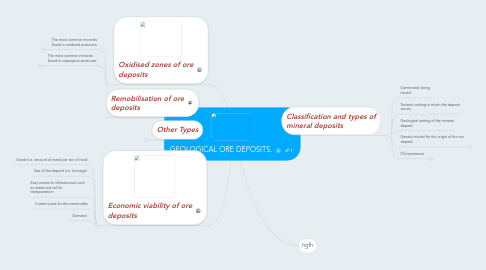
1. Economic viability of ore deposits
1.1. Grade (i.e. amount of metal per ton of rock)
1.2. Size of the deposit (i.e. tonnage)
1.3. Easy access to infrastructure such as roads and rail for transportation
1.4. Current price for the commodity
1.5. Demand
2. Oxidised zones of ore deposits
2.1. The most common minerals found in oxidised zones are:
2.1.1. Copper: malachite, azurite, chrysocolla
2.1.2. Gangue minerals: quartz (usually cryptocrystalline), baryte, calcite, aragonite
2.1.3. Iron: goethite, hematite
2.1.4. Lead: anglesite, cerussite
2.1.5. Manganese: pyrolusite, romanechite, rhodochrosite
2.1.6. Nickel: gaspeite, garnierite
2.1.7. Silver: native silver, chlorargyrite
2.1.8. Zinc: smithsonite
2.2. The most common minerals found in supergene zones are:
2.2.1. Copper: chalcocite, bornite
2.2.2. Lead: supergene galena
2.2.3. Nickel: violarite
2.2.4. Silver: acanthite, native silver
2.2.5. Zinc: supergene sphalerite, wurtzite
3. Remobilisation of ore deposits
4. Other Types
4.1. Archaean gold deposits
4.2. Epithermal gold deposits
4.3. Sedimentary iron ore and manganese deposits
4.4. Placer deposits
4.5. Clay deposits
4.6. Evaporite deposits
4.7. Phosphatic deposits
4.8. Organic deposits
4.9. Residual deposits
5. Classification and types of mineral deposits
5.1. Commodity being mined
5.2. Tectonic setting in which the deposit occurs
5.3. Geological setting of the mineral deposit
5.4. Genetic model for the origin of the ore deposit
5.4.1. Orthomagmatic
5.4.1.1. Orthomagmatic deposits include:
5.4.1.1.1. Chromium
5.4.1.1.2. Titanium
5.4.1.1.3. Iron
5.4.1.1.4. Nickel
5.4.1.1.5. Copper
5.4.1.1.6. Platinum-group elements
5.4.1.1.7. Diamonds
5.4.2. Pneumatolytic and pegmatitic
5.4.2.1. These are important sources for:
5.4.2.1.1. Tin
5.4.2.1.2. Rare-earth elements
5.4.2.1.3. Tantalum
5.4.2.1.4. Beryllium
5.4.2.1.5. Lithium
5.4.2.1.6. Molybdenum
5.4.2.1.7. Tungsten
5.4.3. Hydrothermal deposits
5.4.4. Volcanic or extrusive deposits
5.5. Of importance
5.5.1. Metallic deposits
5.5.2. Non-metallic deposits
5.5.3. Fossil fuel deposits

